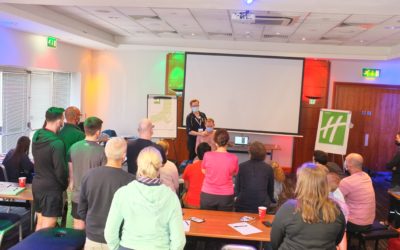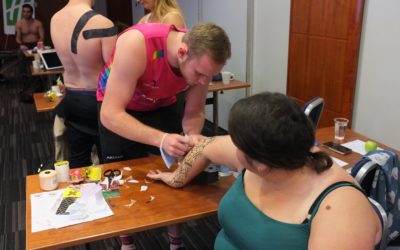Have you considered one of FICS ICSC Hand on Seminars? These are designed to extend your knowledge to prepare you to work with athletes and a requirement to achieve your International Certificate in Sports Chiropractic (ICSC).
The Upper and Lower Extremity Module are delivered in two parts. The online theory (10 hours Upper and 10 hours Lower) and face to face hands-on (10 hours Upper and 10 Hours Lower). Candidates are provided access to the theory 30 days before the face to face hands-on class. This is to ensure the information is fresh when undertaking the practical workshops. Below is a sneak look at what you can expect to learn in the theory sessions.
- Concussion: Dr Brett Jarosz, BAppSc(CompMed), MClinChiro, ICSC PGradDipSportsChiro, CertPT, DACNB, ASCA Level 1, FICC, FAICE, ACA endorsed Fellow Sports & Exercise Chiropractor (AICE 2019), Private Practice: Optimize Sports Chiropractic | South Yarra Spine & Sports Medicine, Allied Health Team: World Surf League. He is an expert in his field and takes you through the epidemiology and pathophysiology of the impact of head injuries; head injury pathophysiology; sideline examination; best practice; return to academics and sport, and injury prevention strategies.
- Mopal CMT Theory: We have two fabulous doctors who deliver the online theory. Dr Tim Ray, deals with Basic Biomechanics and Kinesiology of Manipulative Therapy. He covers some of the foundational principles of Osteo and Arthrokinematics in manual therapy because this will allow us to provide a baseline of understanding. We will follow these principles in the hands-on section of the program. Understanding these principles allows us to model our clinical practices and prevents us from becoming technicians. We always want you to strive to be a clinician, not a technician. We wish to provide you with a practical evidence-based, outcome-driven education, to be able to understand, defend, and appropriately apply this practice or this important aspect of your practice in your care.
- Soft Tissue Interventions: We are very fortunate to have two speakers on the topic of soft tissue interventions and Dr. Mika Janhunen. What is soft tissue work? We all do it. We’ve heard of it. What exactly is soft tissue work? Skilled hand movements that really try to produce a number of different changes. Teaching extensibility, range of motion, mobilization of soft tissues. Sometimes, the soft tissue intervention is simply meant to induce relaxation, to change or modulate pain, or to reduce some sort of movement restriction or tissue swelling or inflammation. Mika, here we go. There are all these acronyms and seemingly very different techniques, but we will cover these and put a little bit of clarity into what they mean. It can seem quite overwhelming if you are a newcomer to the scene. At the same time, is it a good idea to be a purist so that you only use one particular technique, or is it better to mix and match and find bits that work for you amongst lots of different things? What is the correct soft tissue morality and how do you know which one to use?
- Taping: Dr Martin Isaksson is a master instructor and does a lot of taping and a lot of other techniques. If we can harmonize or balance that nervous system, even more, to help our athletes perform better, I am all for it. What we will go through in this session is kinesiology taping. When we talk about kinesiology taping we look at this from the viewpoint of Kenzo Kase. He was the founder of the kinesiology taping method in 1980 which is a long time ago. He did really amazing considering that was the early 80s. Some ins and outs and the research behind taping. We talk about the biomechanical taping in terms of dynamic tape and look at the rigid taping towards the end of the session.
- Emergency Procedures: We are joined by Trish Donoghue and Dr Natalie Sharp. This session is about creating a baseline of information for sports chiropractors, allowing us to create an international base of members, understanding the various approaches to emergency procedures. Many of you already know a lot of this information and may be comfortable with it. Treating athletes on the side of the field, It’s a skill set. You are not in your practice. You don’t have a quiet environment to be able to concentrate one-on-one with the athletes. You need to develop the communication skills and develop the techniques to manage multiple things happening around you, manage things spiralling out of control, and have people in your face shouting at you to make a decision. We will look at the approach to an athlete on the field, sideline assessment and a range of case studies.
- Assessment of the Shoulder. In this module, we are going to spend a good amount of time going through the shoulder and talking about assessment skills and how we’re going to tease apart different shoulder injuries. Dr. Christine Foss, Education Chair for FICS goes through all of the things she has found helpful in her years of practice and working with athletes. You are going to learn how to tease apart a shoulder injury. So when a patient comes to you in your office, we’re going to be able to kind of better understand which structures were looking at, how to specifically assess each particular structure, and how we can kind of think about moving that into a treatment regime and getting that athlete back to play. Whether we have it, what Dr Foss calls is “a go” or “no-go” injury, or something like that which kind of needs to take a little time to heal.
- Assessment wrist, hand and finger: Dr Henry Pollard is a master instructor, Research Chair of FICS. A lot of the shoulder assessments which are very relevant for elbow, wrist, and hand are also going to be covered by Dr. Foss. When considering all this, just general rules of operation, we move from a central poiont. So, from a spine to the extremity peripheral in the direction of my examination, the golden rule of extremities is always examined bilaterally. As a general rule, patients like it if you check out the area that they’re complaining about first, and then, roll through your entire routine. Now, that routine should look at functional assessments, whole body screens, the FMS, and other assessments, a spinal assessment, as well as then the extremity itself. Then, we follow through various stress testing and orthopedic tests which will cover a little bit more in this session, some neuro, and with the upper and lower limb, particularly upper limb, there are a lot of neuro-type conditions.
- Assessment Lower Extremity: Dr Pete Garbutt is a master instructor with FICS. Pete starts with the hip, going to go over a femoroacetabular impingement, labral tears, slipped capital femoral epiphysis, avulsion fractures, and groin injuries. These are some of the more common ones we see in everyday sports chiropractic practice. He moves onto the knee before jumping down to the ankle initially and looks at sprains, stress fractures, tendon injuries, muscle injuries and must more.


